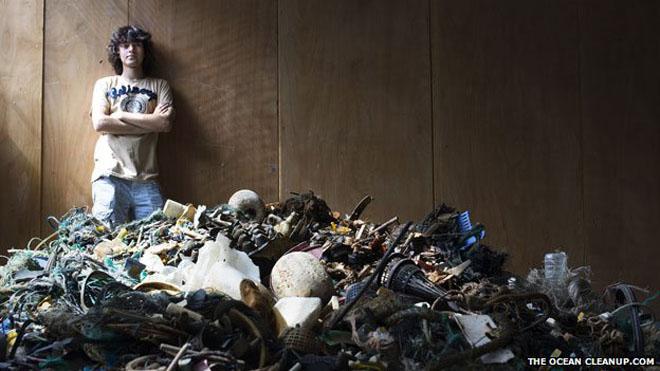Dutch boy on a mission to rid the world's oceans of floating plastic
by Vibeke Venema on 18 Oct 2014

Boyan Slat TheOceanCleanUp.com
Following is an extract from a BBC story. Boyan Slat is a 20-year-old on a mission - to rid the planet's oceans of floating plastic. He has dedicated his teenage years to finding a way of collecting it. But can the system really work - and is there any point when so much new plastic waste is still flowing into the sea every day?
'I don't understand why 'obsessive' has a negative connotation, I'm an obsessive and I like it,' says Boyan Slat. 'I get an idea and I stick to it.'
This idea came to him at the age of 16, in the summer of 2011, when diving in Greece. 'I saw more plastic bags than fish,' says Slat. He was shocked, and even more shocked that there was no apparent solution. 'Everyone said to me: 'Oh there's nothing you can do about plastic once it gets into the oceans,' and I wondered whether that was true.'
Global production of plastic now stands at 288 million tonnes per year, of which 10% ends up in the ocean in time. Most of that - 80% - comes from land-based sources. Litter gets swept into drains, and ends up in rivers - so that plastic straw or cup lid you dropped, the cigarette butt you threw on the road… they could all end up in the sea.
The plastic is carried by currents and congregates in five revolving water systems, called gyres, in the major oceans, the most infamous being the huge Pacific Garbage Patch, half way between Hawaii and California.
Although the concentration of plastic in these areas is high - it's sometimes described as a plastic soup - it's still spread out over an area twice the size of Texas. What's more, the plastic does not stay in one spot, it rotates. These factors make a clean-up incredibly challenging.
'Most people have this image of an island of trash that you can almost walk on, but that's not what it's like,' says Slat. 'It stretches for millions of square kilometres - if you went there to try and clean up by ship it would take thousands of years.' Not only that, it would be very costly in terms of both money and energy, and fish would be accidentally caught in the nets.
Slat had always enjoyed working out solutions to puzzles, and while pondering this one, it came to him - rather than chase plastic, why not harness the currents and wait for it to come to you?
At school, Slat developed his idea further as part of a science project. An array of floating barriers, anchored to the sea bed, would first catch and concentrate the floating debris. The plastic would move along the barriers towards a platform, where it could then be efficiently extracted. The ocean current would pass underneath the barriers, taking all buoyant sea life with it.
There would be no emissions, and no nets for marine life to get entangled in. The collected ocean plastic would be recycled and made into products - or oil.
The high school science project was awarded Best Technical Design at Delft University of Technology. For most teenagers, it would probably have ended there, but Slat was different.
He had been interested in engineering from a very young age. 'First I built tree houses, then zip-wires, then it evolved towards bigger things,' he says. 'By the time I was 13, I was very interested in rocketry.'
This led him to set a Guinness World Record for the most water rockets launched at the same time: 213, from a sports field in his native Delft. 'The experience taught me how to get people crazy enough to do things you want, and how to approach sponsors.' Useful skills, as it turned out.
And on the story Click here to read the full story.
If you want to link to this article then please use this URL: www.sailworldcruising.com/127948